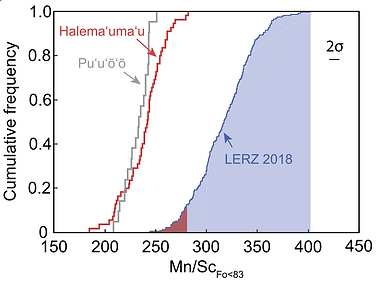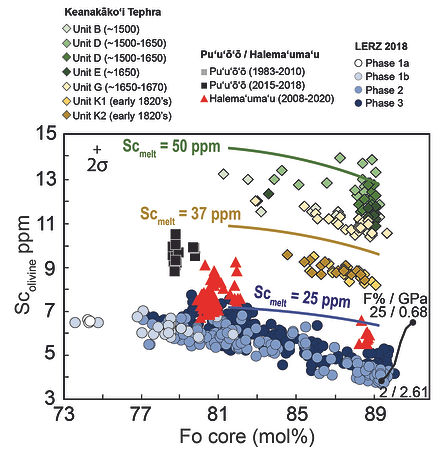top of page
For more than a decade now, geologists have found that Kilauea undergoes cycles of century long explosive activity (last was between ~1500-1800CE) alternating w/ long cycles of dominantly effusive, lava flow activity (1800-present).

Figure from Lynn and Swanson 2022
I tracked the evolution of olivine and melt compositions over the past 500 years at Kīlauea Volcano, as well as variations in mantle potential temperature, pressure and oxygen fugacity, using trace elements in olivine. Trace element in olivine data acquired with laser ablation at the Earth Observatory of Singapore. We measured trace element in olivine picked from several century-old eruptions and from recent 21st century Kīlauea eruptions.
We found that the magma feeding Pu‘u‘ō‘ō played little role in the 2018 lower East Rift Zone eruption at Kīlauea Perhaps Puʻuʻōʻō never formed a large reservoir where they were accumulated over years.

Cumulative frequency plot of Mn/Sc values in Fo<83 olivine. This ratio helps to discriminate olivine from the recent Pu‘u‘ō‘ō (2015–2018) or Halema‘uma‘u (2008–2020) from the LERZ 2018 olivine. The red and blue areas for the LERZ 2018 olivine highlight the potential contribution from Pu‘u‘ō‘ō and Halema‘uma‘u (<10%), and from the South Caldera reservoirs (>90%), respectively
Some elements at parts per million levels in olivine, like Sc, are great at fingerprinting changes in the parental magmas that feed Kilauea through time (green = 1500s, blue = 2018 flank, red is 2008-2018 summit)

Sc versus Fo content. Melts in equilibrium with Fo81-90 olivine only fractionate olivine. Higher Sc contents in olivine from the 1500-1820's eruptions cannot be modeled with the same mantle composition as for the 2018 LERZ olivine and require a change in the source composition. Fractional crystallization models (blue, orange and green curve) show changes in Sc and Fo in olivine during fractional crystallization as a function of Sc concentration in the starting melt. Higher Sc concentration (up to 50ppm) in primitive melts could explain the measured variations in Sc.
What these changes tell us is that the chemistry of the melts coming from the mantle has been changing over the last 500 years, melting a mantle that contains more of the mineral clinopyroxene. This means a mantle that is easier to melt.

Batch melting calculations using Fo>87 olivine compositions.
If interested in learning more, take a look at Mourey et al. (2022).
Publication: Mourey, A.J., Shea, T., Lynn, K.J., Lerner, A.H., Lambart, S., Costa, F., Oalmann, J., Lopaka Lee, R., Gansecki, C., 2022. Trace elements in olivine fingerprint the source of 2018 magmas and shed light on explosive-effusive eruption cycles at Kīlauea Volcano. Earth and Planetary Science Letters 595, 117769
bottom of page